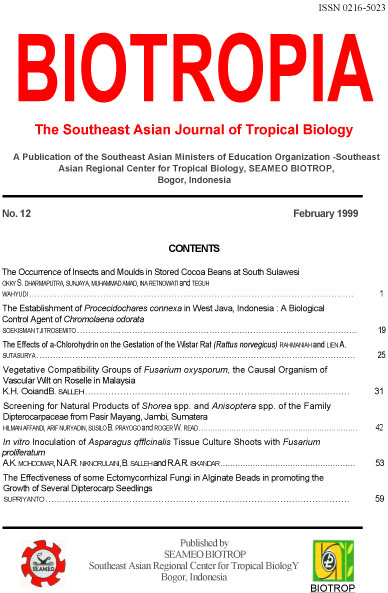
SEAMEO BIOTROP
Southeast Asian Ministers of Education Organization
624
views
Tags
THE ESTABLISHMENT OF PROCECIDOCHARES CONNEXA IN WEST JAVA, INDONESIA : A BIOLOGICAL CONTROL AGENT OF CHROMOLAENA ODORATA
24 May 2019 - 10:32 am (6 year ago)
Content Language : English
Content Language : English

Category :
Applied Science
Kirinyu (Chromolaena odorata (L.) R.M. King and H. Robinson) was reported for the first time
in 1934 from Lubuk Pakam North Sumatera. It grows vegetatively during the wet season, flowers and
sets a high number of fruits at the end of the wet season, and senesces during the dry season. It
may be controlled manually by uprooting the weed or by slashing, and chemically by spraying with
herbicides. However, this has not been successful. Recently a biological control agent,
Procecidochares connexa was introduced at Parung Panjang, West Java, as a biological control
agent of C. odorata. This paper reports the successful establishment of Procecidochares connexa.
Two releases of P. connexa colonies were made in Parung Panjang at the end of 1995. The colony
was able to survive through a harsh dry season of 1997. When C. odorata was swept by fire, the
emerging shoots soon were attacked by P. connexa. The population of C. odorata went down to
37.2% with 31.8% of its emerging shoots attacked by P. connexa in a 2-year period. When twigs were
attacked by P. connexa, the production of cypsellas was reduced by about 50% in one season.
However, the survival of emerging flies was also affected by the death of twigs upon maturation of the
cypsellas.
in 1934 from Lubuk Pakam North Sumatera. It grows vegetatively during the wet season, flowers and
sets a high number of fruits at the end of the wet season, and senesces during the dry season. It
may be controlled manually by uprooting the weed or by slashing, and chemically by spraying with
herbicides. However, this has not been successful. Recently a biological control agent,
Procecidochares connexa was introduced at Parung Panjang, West Java, as a biological control
agent of C. odorata. This paper reports the successful establishment of Procecidochares connexa.
Two releases of P. connexa colonies were made in Parung Panjang at the end of 1995. The colony
was able to survive through a harsh dry season of 1997. When C. odorata was swept by fire, the
emerging shoots soon were attacked by P. connexa. The population of C. odorata went down to
37.2% with 31.8% of its emerging shoots attacked by P. connexa in a 2-year period. When twigs were
attacked by P. connexa, the production of cypsellas was reduced by about 50% in one season.
However, the survival of emerging flies was also affected by the death of twigs upon maturation of the
cypsellas.
Link

This work is licensed under a Creative Commons Attribution-NonCommercial-NoDerivatives 4.0 International License.
